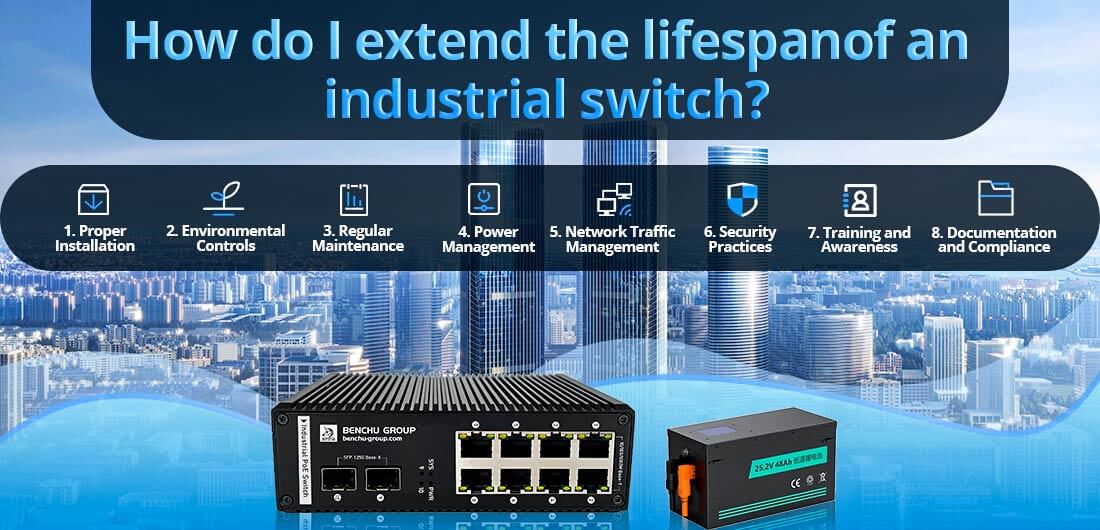
Extending the lifespan of an industrial switch involves implementing best practices for maintenance, environmental control, and proper usage. Here’s a detailed description of strategies to enhance the longevity of your industrial switches:
1. Proper Installation
a. Environment Considerations
--- Avoid Harsh Conditions: Install switches in environments that meet their specifications for temperature, humidity, and exposure to dust or corrosive substances. Use enclosures or cabinets if necessary.
b. Mounting Practices
--- Secure Mounting: Ensure switches are mounted securely to avoid vibrations and shocks that can damage internal components. Use appropriate brackets or mounting solutions.
2. Environmental Controls
a. Temperature Management
--- Cooling Solutions: Use fans or HVAC systems to maintain an optimal operating temperature, typically between 0°C and 60°C (32°F to 140°F) for most industrial switches.
--- Avoid Direct Sunlight: Position switches away from direct sunlight or heat sources to prevent overheating.
b. Dust and Moisture Protection
--- Use Dust Filters: Implement dust filters and regular cleaning routines to prevent dust buildup, which can lead to overheating and equipment failure.
--- Seal against Moisture: Ensure that switches are IP-rated appropriately for the environment (e.g., IP67 for outdoor use) to protect against moisture ingress.
3. Regular Maintenance
a. Routine Inspections
--- Scheduled Checkups: Conduct regular inspections to check for physical damage, dust accumulation, and loose connections. This can help identify issues before they lead to failure.
b. Firmware Updates
--- Keep Software Current: Regularly update firmware and software to patch vulnerabilities and improve performance. Follow the manufacturer’s guidelines for updates.
4. Power Management
a. Stable Power Supply
--- Use UPS: Utilize an uninterruptible power supply (UPS) to protect switches from power surges, spikes, and outages that can damage internal components.
b. Power Over Ethernet (PoE) Management
--- Limit PoE Usage: If using PoE, ensure that the total power consumption does not exceed the switch's capacity. Overloading can lead to overheating and hardware failure.
5. Network Traffic Management
a. Load Balancing
--- Distribute Network Load: Implement load balancing techniques to prevent any single switch from becoming overloaded, which can lead to overheating and reduced lifespan.
b. Monitor Performance
--- Use Network Management Tools: Regularly monitor network performance and traffic patterns to identify potential issues and optimize configurations.
6. Security Practices
a. Implement Security Protocols
--- Secure Access Control: Use strong passwords, multi-factor authentication, and role-based access controls to protect against unauthorized access that could lead to malfunctions or breaches.
b. Intrusion Detection
--- Deploy IDS/IPS: Utilize intrusion detection and prevention systems to monitor network traffic for malicious activity, helping to avoid damage from cyberattacks.
7. Training and Awareness
a. Staff Training
--- Educate Personnel: Train staff on proper usage, handling, and troubleshooting procedures for industrial switches to prevent accidental damage and misuse.
b. Incident Response Planning
--- Prepare for Issues: Develop and regularly update an incident response plan to address potential failures or security incidents quickly and effectively.
8. Documentation and Compliance
a. Maintain Records
--- Keep Maintenance Logs: Document inspections, updates, and repairs to keep track of the switch’s history and help identify recurring issues.
b. Compliance with Standards
--- Follow Manufacturer Guidelines: Adhere to the manufacturer’s recommendations and industry standards for installation, operation, and maintenance to ensure optimal performance and longevity.
Conclusion
By implementing these strategies—focused on installation, environmental controls, maintenance, power management, network traffic management, security practices, training, and documentation—you can significantly extend the lifespan of your industrial switches. Proactive measures not only enhance reliability but also reduce the total cost of ownership by minimizing downtime and the need for frequent replacements.